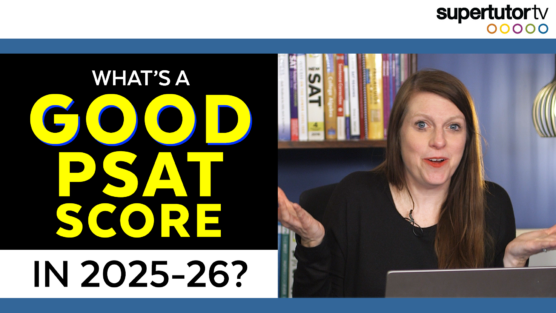So, you’re taking the ACT really soon. Maybe it’s in two days, maybe it’s in two hours, but what are some last-minute tips that actually work? That’s what we’re going to talk about in this blog.
Do Not Read the “Grammatically Acceptable” Question Stems
Number one, let’s start with some English. Don’t read the “grammatically acceptable” question stems. Now, some of you are probably asking, what is a question stem? A question stem is just the wording of the question itself that’s next to the number. And on the ACT, it used to be that a lot of questions didn’t have a question at all. And the ACT just told students that the default is to pick the best grammatical answer choice unless there is a question. But now the question is: Which choice makes the sentence most grammatically acceptable? That probably didn’t take very long to read, but imagine multiplying that by 30. That’s going to take a couple of minutes off the time that you have to answer questions on the English section. And while a lot of students don’t feel super rushed, there’s no reason to put yourself in a position where you might be. So my advice on these is just skim your eyes to the right side for each question and see if you see that word “grammatically” because it lands sort of on the right side of the column. If you see that word grammatically, don’t read the question. Just pick the best choice grammatically. It’s just a quick little speed tip to save yourself two minutes on the English section, and that maybe is two extra points if you get two more questions right.
Pay Attention to What the Question Actually Asks For
The second tip is when you have a question stem that isn’t “Which choice makes the sentence most grammatically acceptable,” you are not supposed to just put what sounds best. You need to do whatever the question asks you for. And this is one of the number one mistakes that my students make who I start prepping with, and it’s such an easy fix, and that’s why this is a last-minute ACT tip. It’s something that’s super easy to correct if you’re just aware of it. If it says which choice is clearest and most precise in context, the idea of being really clear and really precise is super important. That’s the most important thing. If I see “Which choice best helps indicate that each historical epic covered different subject matter,” I need the answer choice that does exactly what it asks for. I don’t care if the answer choice sounds like it was written by a third grader. That’s not what this is about. This is not the most grammatically correct. This is not which of these sounds the best. It is very specific to whatever that question stem says, and you need to pay attention to that, and that wins above all. So, if you understand and know that, it’s just going to help you make choices that help you get things right. And it’s a very simple concept and so great to cram.
Learn Your Punctuation!
Number three, if you’re trying to up your English score and you don’t have a lot of time, I will just tell you from working with students for two decades that the number one kind of question that my students miss in the English section is punctuation—colons, dashes, semicolons, and commas. If you only have time to study one thing, that is what I would study. I would study punctuation, and as a gift to you guys, I have created a punctuation cheat sheet. So, if you don’t have time to Google a comma video on YouTube right now and all you have time for is to print something out before you run to your ACT test center, we have you covered.
You can find my ACT Grammar Cheat Sheet at supertutortv.com/free!
And that will give you my quick rundown of comma, colon, dash, and semicolon rules. But again, going through a whole lesson might be worth it if you’ve got a day or two.
Learn to Use Your Calculator
Tip number four is a math tip, and that is to learn to use your calculator. You don’t have a lot of time to run a lot of math drills and deeply learn concepts that you don’t know very well, but you do have time to learn a few tips and tricks on your calculator. What can you do on your calculator really quickly? You can multiply, add, and subtract matrices. You can run simple programs. We actually have a whole package of simple programs, and we have a video on how to put programs on your calculator, which you can check out on our channel. You can run permutations and combinations—NPR and NCR—in the probability functionality of your calculator. You can solve expressions with “i.” If you don’t know where the “i” is on your TI-84, I recommend that you Google it and figure it out, because if you have any questions that have “i” in them, it makes it so much easier. You can graph complex equations and solve them by graphing.
One of the things that happens to a lot of my students is that we have these complicated questions, but my rule of thumb is that for anything that’s more complicated than a quadratic, about 70% of the time, I’m using graphing to solve it. If you have something that has crazy weird exponents or if it’s got the third or fourth power and is starting to get complicated, graph the thing and pluck points to find the zeros instead of trying to factor something that’s ridiculous and difficult. It’s also multiple choice, and so you can backsolve from the graph and things like that. If you’re trying to solve something complicated, remember you can solve it by graphing.
Another thing you can do is you can convert fractions to decimals and decimals to fractions. If you don’t know how to do that, you should figure it out. You hit “math,” then “frac,” and then “enter” on the TI-84, and it’s super easy. That’s how you convert to a fraction, but you can also convert back to a decimal from that same math menu. You can also find the sine, cosine, and tangent of anything. As I like to say, if you have a problem that’s got a bunch of sines and cosines in it, and you’re not quite sure how to do it the right way, use your calculator’s built-in functions to figure it out if you don’t immediately know the answer. That’s just a quick rundown of some of those features on your calculator, so again, I recommend that you get to know your calculator and download some programs if you’ve got a TI-84.
Study Formulas
My second big tip is to study formulas. The SAT has this lovely little cheat sheet that reminds you of the Pythagorean theorem and the area of a cylinder. The ACT has no such thing; you are totally on your own, and there is nothing worse than when my students get an ACT question wrong because they couldn’t remember the law of sines or the law of cosines or the Pythagorean theorem. I really don’t want that to be you, and so I have a present for you: a math cheat sheet. You can also find that at supertutortv.com/free.
This Is Not a Closed-Book Test
My first tip for the reading section is that this is not a closed-book test. Many of you enter the world of reading comprehension like you did in high school, when your teacher assigned you a reading assignment. You read it at home, come to class, and have to remember everything and answer all the questions. Not how the ACT works. It’s open-book, so I want you to treat this test differently if you’re not doing it already. And that means every time you’re reading a question, go back and check your answers. Do not guess; go back and check, go back and check, go back and check, go back and check. Go quickly, but go back and check, because there’s something going on in the ACT, and that’s that every answer choice usually mentions something from the passage. Most of the time in high school, you have these recognition tests where the goal is to prove that you read. So when you see “yellow boots” in the answer choice, you remember reading that, and your whole goal on those tests is just to remember reading something. That’s not the ACT. The question isn’t just “Do you remember reading this?” You want to read the question carefully, go back to the text, and figure out what the answer is.
Map the Passage
So, in order to do that more effectively, we’re going to get to the next tip, which is to do a map of the passage. You don’t get any brownie points for reading every word on the ACT; you get points for getting questions right. So, you want to read the passage in a way where you summarize each paragraph so that you know what kind of information is in each paragraph. Then, you’ll know where to go when you need to double-check your answers.
The other thing that I remind students of when you’re mapping a passage is you don’t want to get bogged down in any one section. You may get bogged down in an area that doesn’t make sense, but that area may have zero questions on it, and then you just wasted a minute and a half trying to understand three lines that don’t matter. Before you do that, what I always tell students is when you’re mapping a passage, if something’s confusing, then I want you to back up and just think, “What is where?” If the main character is fighting with her dad about something, you maybe don’t understand that, but that’s the fight with Dad, so if you get a question about her fighting with her dad, you know where to go. And that’s what’s most important; knowing where to go is more important than memorizing everything as you read. If you make that adjustment, you’re going to be able to be more accurate and still keep within the time on the ACT reading section.
Do Not Read the Passages First
My number one tip for the science section is do not read the passages first. Chances are you’re not going to be able to memorize all of the things that those science passages say. I do have some students for whom that idea makes them really nervous, and so they will read just the first two lines or so just to get a little bit familiar with what is going on and what kind of experiment this is. If you feel like you’re in that 10%, that’s fine; do that. But for 90% of my students, they don’t read the passage first. They get into the questions first and figure out what they’re looking for, and then they go and find it in the charts, graphs, or experiments. It doesn’t mean to never read the passage; it just means to get to that reading when you need it, because the science is so technical and so specific it is literally nearly impossible to memorize unless you have the memory of an elephant.
Track Every Detail As You Go
Next: check off every detail and track every detail as you go. In terms of the process on the science section—and science is great because you can really improve your score a lot just by changing up your process—your pencil is your best friend. If you’re taking this on paper—if you’re not taking it on paper, you can still use the highlighter to do this—what you want to do is make sure that you don’t drop any details as you go through the question. I even recommend that students read the question a chunk at a time and never read beyond what they can hold in their brain or really comprehend. You don’t want to get to the point where you read the question and have no idea what you just read. And that can happen in the science section because it’s so detail-oriented.
So, if you read a little detail and it says “according to figure one,” go to figure one. If it says “the number of tadpoles that survived in the experimental pond,” stop and go back to the graph and figure out where the tadpoles are and where the experimental pond is. Check off each detail, and that helps make sure that you don’t miss anything. Digest it one little bit at a time; stop and go back, stop and go back. Just make sure you don’t miss anything in that question on science, and that’s going to help you get a better score.
Take a Real Practice Test and Go Over Your Answers
Finally, I have one last tip—and this is for all the sections—and that’s to take a real practice test and go over your answers. If you’ve already done this multiple times, pat yourself on the back because you’re on your way to getting a better ACT score. If you haven’t done it yet, it’s one of the most important things you can do to familiarize yourself with this exam. There are two that have been released by ACT at this point. I think they’ve just added a new test, which of course is a lot of questions that have been recycled from past guides if you studied for the earlier version. But in any case, you’ve got four in the book, you’ve got one online for now in 2025, and hopefully they’re going to be adding more to the book each year and more online to practice with.
But practice with real materials. You can also use legacy ACTs to practice if you can get ahold of them. There are old legacy guides, and if you look at my Amazon reviews, you might notice that Brooke Hansen is an avid Amazon reviewer of the ACT Official Guide. I will go through all of the form codes and all my Amazon reviews of which tests are in it. So, if you’re trying to get some more practice tests beyond the ones that have been recycled into this, you can piece it together and order some more of those gently used books from Amazon to get more practice for yourself. Go over your practice tests to figure out what you missed and why, and how you can do better next time. Hope this was helpful!




